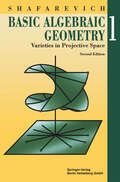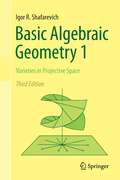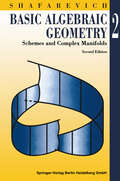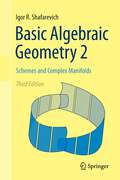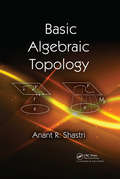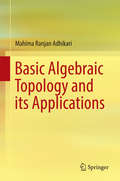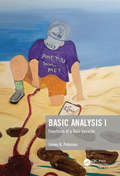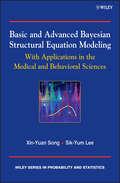- Table View
- List View
Basic Algebraic Geometry 1
by Igor R. ShafarevichThis book is a revised and expanded new edition of the first four chapters of Shafarevich’s well-known introductory book on algebraic geometry. Besides correcting misprints and inaccuracies, the author has added plenty of new material, mostly concrete geometrical material such as Grassmannian varieties, plane cubic curves, the cubic surface, degenerations of quadrics and elliptic curves, the Bertini theorems, and normal surface singularities.
Basic Algebraic Geometry 1: Varieties in Projective Space
by Igor R. ShafarevichShafarevich's Basic Algebraic Geometry has been a classic and universally used introduction to the subject since its first appearance over 40 years ago. As the translator writes in a prefatory note, ``For all [advanced undergraduate and beginning graduate] students, and for the many specialists in other branches of math who need a liberal education in algebraic geometry, Shafarevich’s book is a must.'' The third edition, in addition to some minor corrections, now offers a new treatment of the Riemann--Roch theorem for curves, including a proof from first principles.Shafarevich's book is an attractive and accessible introduction to algebraic geometry, suitable for beginning students and nonspecialists, and the new edition is set to remain a popular introduction to the field.
Basic Algebraic Geometry 2: Schemes and Complex Manifolds
by Igor R. ShafarevichThe second volume of Shafarevich's introductory book on algebraic geometry focuses on schemes, complex algebraic varieties and complex manifolds. As with first volume the author has revised the text and added new material. Although the material is more advanced than in Volume 1 the algebraic apparatus is kept to a minimum making the book accessible to non-specialists. It can be read independently of the first volume and is suitable for beginning graduate students.
Basic Algebraic Geometry 2: Schemes and Complex Manifolds
by Igor R. ShafarevichShafarevich's Basic Algebraic Geometry has been a classic and universally used introduction to the subject since its first appearance over 40 years ago. As the translator writes in a prefatory note, ``For all [advanced undergraduate and beginning graduate] students, and for the many specialists in other branches of math who need a liberal education in algebraic geometry, Shafarevich’s book is a must.''The second volume is in two parts: Book II is a gentle cultural introduction to scheme theory, with the first aim of putting abstract algebraic varieties on a firm foundation; a second aim is to introduce Hilbert schemes and moduli spaces, that serve as parameter spaces for other geometric constructions. Book III discusses complex manifolds and their relation with algebraic varieties, Kähler geometry and Hodge theory. The final section raises an important problem in uniformising higher dimensional varieties that has been widely studied as the ``Shafarevich conjecture''.The style of Basic Algebraic Geometry 2 and its minimal prerequisites make it to a large extent independent of Basic Algebraic Geometry 1, and accessible to beginning graduate students in mathematics and in theoretical physics.
Basic Algebraic Topology
by Anant R. ShastriBuilding on rudimentary knowledge of real analysis, point-set topology, and basic algebra, Basic Algebraic Topology provides plenty of material for a two-semester course in algebraic topology. The book first introduces the necessary fundamental concepts, such as relative homotopy, fibrations and cofibrations, category theory, cell complexes, and si
Basic Algebraic Topology
by Anant R. ShastriBuilding on rudimentary knowledge of real analysis, point-set topology, and basic algebra, Basic Algebraic Topology provides plenty of material for a two-semester course in algebraic topology. The book first introduces the necessary fundamental concepts, such as relative homotopy, fibrations and cofibrations, category theory, cell complexes, and si
Basic Algebraic Topology and its Applications
by Mahima Ranjan AdhikariThis book provides an accessible introduction to algebraic topology, a field at the intersection of topology, geometry and algebra, together with its applications. Moreover, it covers several related topics that are in fact important in the overall scheme of algebraic topology. Comprising eighteen chapters and two appendices, the book integrates various concepts of algebraic topology, supported by examples, exercises, applications and historical notes. Primarily intended as a textbook, the book offers a valuable resource for undergraduate, postgraduate and advanced mathematics students alike.Focusing more on the geometric than on algebraic aspects of the subject, as well as its natural development, the book conveys the basic language of modern algebraic topology by exploring homotopy, homology and cohomology theories, and examines a variety of spaces: spheres, projective spaces, classical groups and their quotient spaces, function spaces, polyhedra, topological groups, Lie groups and cell complexes, etc. The book studies a variety of maps, which are continuous functions between spaces. It also reveals the importance of algebraic topology in contemporary mathematics, theoretical physics, computer science, chemistry, economics, and the biological and medical sciences, and encourages students to engage in further study.
Basic Analysis I: Functions of a Real Variable
by James K. PetersonBasic Analysis I: Functions of a Real Variable is designed for students who have completed the usual calculus and ordinary differential equation sequence and a basic course in linear algebra. This is a critical course in the use of abstraction, but is just first volume in a sequence of courses which prepare students to become practicing scientists. This book is written with the aim of balancing the theory and abstraction with clear explanations and arguments, so that students who are from a variety of different areas can follow this text and use it profitably for self-study. It can also be used as a supplementary text for anyone whose work requires that they begin to assimilate more abstract mathematical concepts as part of their professional growth. Features Can be used as a traditional textbook as well as for self-study Suitable for undergraduate mathematics students, or for those in other disciplines requiring a solid grounding in abstraction Emphasises learning how to understand the consequences of assumptions using a variety of tools to provide the proofs of propositions
Basic Analysis I: Functions of a Real Variable
by James K. PetersonBasic Analysis I: Functions of a Real Variable is designed for students who have completed the usual calculus and ordinary differential equation sequence and a basic course in linear algebra. This is a critical course in the use of abstraction, but is just first volume in a sequence of courses which prepare students to become practicing scientists. This book is written with the aim of balancing the theory and abstraction with clear explanations and arguments, so that students who are from a variety of different areas can follow this text and use it profitably for self-study. It can also be used as a supplementary text for anyone whose work requires that they begin to assimilate more abstract mathematical concepts as part of their professional growth. Features Can be used as a traditional textbook as well as for self-study Suitable for undergraduate mathematics students, or for those in other disciplines requiring a solid grounding in abstraction Emphasises learning how to understand the consequences of assumptions using a variety of tools to provide the proofs of propositions
Basic Analysis II: A Modern Calculus in Many Variables
by James K. PetersonBasic Analysis II: A Modern Calculus in Many Variables focuses on differentiation in Rn and important concepts about mappings from Rn to Rm, such as the inverse and implicit function theorem and change of variable formulae for multidimensional integration. These topics converge nicely with many other important applied and theoretical areas which are no longer covered in mathematical science curricula. Although it follows on from the preceding volume, this is a self-contained book, accessible to undergraduates with a minimal grounding in analysis. Features Can be used as a traditional textbook as well as for self-study Suitable for undergraduates in mathematics and associated disciplines Emphasises learning how to understand the consequences of assumptions using a variety of tools to provide the proofs of propositions
Basic Analysis II: A Modern Calculus in Many Variables
by James K. PetersonBasic Analysis II: A Modern Calculus in Many Variables focuses on differentiation in Rn and important concepts about mappings from Rn to Rm, such as the inverse and implicit function theorem and change of variable formulae for multidimensional integration. These topics converge nicely with many other important applied and theoretical areas which are no longer covered in mathematical science curricula. Although it follows on from the preceding volume, this is a self-contained book, accessible to undergraduates with a minimal grounding in analysis. Features Can be used as a traditional textbook as well as for self-study Suitable for undergraduates in mathematics and associated disciplines Emphasises learning how to understand the consequences of assumptions using a variety of tools to provide the proofs of propositions
Basic Analysis III: Mappings on Infinite Dimensional Spaces
by James K. PetersonBasic Analysis III: Mappings on Infinite Dimensional Spaces is intended as a first course in abstract linear analysis. This textbook cover metric spaces, normed linear spaces and inner product spaces, along with many other deeper abstract ideas such a completeness, operators and dual spaces. These topics act as an important tool in the development of a mathematically trained scientist. Feature: Can be used as a traditional textbook as well as for self-study Suitable for undergraduates in mathematics and associated disciplines Emphasizes learning how to understand the consequences of assumptions using a variety of tools to provide the proofs of propositions
Basic Analysis III: Mappings on Infinite Dimensional Spaces
by James K. PetersonBasic Analysis III: Mappings on Infinite Dimensional Spaces is intended as a first course in abstract linear analysis. This textbook cover metric spaces, normed linear spaces and inner product spaces, along with many other deeper abstract ideas such a completeness, operators and dual spaces. These topics act as an important tool in the development of a mathematically trained scientist. Feature: Can be used as a traditional textbook as well as for self-study Suitable for undergraduates in mathematics and associated disciplines Emphasizes learning how to understand the consequences of assumptions using a variety of tools to provide the proofs of propositions
Basic Analysis IV: Measure Theory and Integration
by James K. PetersonBasic Analysis IV: Measure Theory and Integration introduces students to concepts from measure theory and continues their training in the abstract way of looking at the world. This is a most important skill to have when your life's work will involve quantitative modeling to gain insight into the real world. This text generalizes the notion of integration to a very abstract setting in a variety of ways. We generalize the notion of the length of an interval to the measure of a set and learn how to construct the usual ideas from integration using measures. We discuss carefully the many notions of convergence that measure theory provides. Features • Can be used as a traditional textbook as well as for self-study • Suitable for advanced students in mathematics and associated disciplines• Emphasises learning how to understand the consequences of assumptions using a variety of tools to provide the proofs of propositions
Basic Analysis IV: Measure Theory and Integration
by James K. PetersonBasic Analysis IV: Measure Theory and Integration introduces students to concepts from measure theory and continues their training in the abstract way of looking at the world. This is a most important skill to have when your life's work will involve quantitative modeling to gain insight into the real world. This text generalizes the notion of integration to a very abstract setting in a variety of ways. We generalize the notion of the length of an interval to the measure of a set and learn how to construct the usual ideas from integration using measures. We discuss carefully the many notions of convergence that measure theory provides. Features • Can be used as a traditional textbook as well as for self-study • Suitable for advanced students in mathematics and associated disciplines• Emphasises learning how to understand the consequences of assumptions using a variety of tools to provide the proofs of propositions
Basic Analysis of Regularized Series and Products (Lecture Notes in Mathematics #1564)
by Jay Jorgenson Serge LangAnalytic number theory and part of the spectral theory of operators (differential, pseudo-differential, elliptic, etc.) are being merged under amore general analytic theory of regularized products of certain sequences satisfying a few basic axioms. The most basic examples consist of the sequence of natural numbers, the sequence of zeros with positive imaginary part of the Riemann zeta function, and the sequence of eigenvalues, say of a positive Laplacian on a compact or certain cases of non-compact manifolds. The resulting theory is applicable to ergodic theory and dynamical systems; to the zeta and L-functions of number theory or representation theory and modular forms; to Selberg-like zeta functions; andto the theory of regularized determinants familiar in physics and other parts of mathematics. Aside from presenting a systematic account of widely scattered results, the theory also provides new results. One part of the theory deals with complex analytic properties, and another part deals with Fourier analysis. Typical examples are given. This LNM provides basic results which are and will be used in further papers, starting with a general formulation of Cram r's theorem and explicit formulas. The exposition is self-contained (except for far-reaching examples), requiring only standard knowledge of analysis.
Basic Analysis V: Functional Analysis and Topology
by James K. PetersonBasic Analysis V: Functional Analysis and Topology introduces graduate students in science to concepts from topology and functional analysis, both linear and nonlinear. It is the fifth book in a series designed to train interested readers how to think properly using mathematical abstractions, and how to use the tools of mathematical analysis in applications. It is important to realize that the most difficult part of applying mathematical reasoning to a new problem domain is choosing the underlying mathematical framework to use on the problem. Once that choice is made, we have many tools we can use to solve the problem. However, a different choice would open up avenues of analysis from a different, perhaps more productive, perspective. In this volume, the nature of these critical choices is discussed using applications involving the immune system and cognition. Features Develops a proof of the Jordan Canonical form to show some basic ideas in algebraic topology Provides a thorough treatment of topological spaces, finishing with the Krein–Milman theorem Discusses topological degree theory (Brouwer, Leray–Schauder, and Coincidence) Carefully develops manifolds and functions on manifolds ending with Riemannian metrics Suitable for advanced students in mathematics and associated disciplines Can be used as a traditional textbook as well as for self-study Author James K. Peterson is an Emeritus Professor at the School of Mathematical and Statistical Sciences, Clemson University. He tries hard to build interesting models of complex phenomena using a blend of mathematics, computation, and science. To this end, he has written four books on how to teach such things to biologists and cognitive scientists. These books grew out of his Calculus for Biologists courses offered to the biology majors from 2007 to 2015. He has taught the analysis courses since he started teaching both at Clemson and at his previous post at Michigan Technological University. In between, he spent time as a senior engineer in various aerospace firms and even did a short stint in a software development company. The problems he was exposed to were very hard, and not amenable to solution using just one approach. Using tools from many branches of mathematics, from many types of computational languages, and from first-principles analysis of natural phenomena was absolutely essential to make progress. In both mathematical and applied areas, students often need to use advanced mathematics tools they have not learned properly. So, he has recently written a series of five books on mathematical analysis to help researchers with the problem of learning new things after they have earned their degrees and are practicing scientists. Along the way, he has also written papers in immunology, cognitive science, and neural network technology, in addition to having grants from the NSF, NASA, and the US Army. He also likes to paint, build furniture, and write stories.
Basic Analysis V: Functional Analysis and Topology
by James K. PetersonBasic Analysis V: Functional Analysis and Topology introduces graduate students in science to concepts from topology and functional analysis, both linear and nonlinear. It is the fifth book in a series designed to train interested readers how to think properly using mathematical abstractions, and how to use the tools of mathematical analysis in applications. It is important to realize that the most difficult part of applying mathematical reasoning to a new problem domain is choosing the underlying mathematical framework to use on the problem. Once that choice is made, we have many tools we can use to solve the problem. However, a different choice would open up avenues of analysis from a different, perhaps more productive, perspective. In this volume, the nature of these critical choices is discussed using applications involving the immune system and cognition. Features Develops a proof of the Jordan Canonical form to show some basic ideas in algebraic topology Provides a thorough treatment of topological spaces, finishing with the Krein–Milman theorem Discusses topological degree theory (Brouwer, Leray–Schauder, and Coincidence) Carefully develops manifolds and functions on manifolds ending with Riemannian metrics Suitable for advanced students in mathematics and associated disciplines Can be used as a traditional textbook as well as for self-study Author James K. Peterson is an Emeritus Professor at the School of Mathematical and Statistical Sciences, Clemson University. He tries hard to build interesting models of complex phenomena using a blend of mathematics, computation, and science. To this end, he has written four books on how to teach such things to biologists and cognitive scientists. These books grew out of his Calculus for Biologists courses offered to the biology majors from 2007 to 2015. He has taught the analysis courses since he started teaching both at Clemson and at his previous post at Michigan Technological University. In between, he spent time as a senior engineer in various aerospace firms and even did a short stint in a software development company. The problems he was exposed to were very hard, and not amenable to solution using just one approach. Using tools from many branches of mathematics, from many types of computational languages, and from first-principles analysis of natural phenomena was absolutely essential to make progress. In both mathematical and applied areas, students often need to use advanced mathematics tools they have not learned properly. So, he has recently written a series of five books on mathematical analysis to help researchers with the problem of learning new things after they have earned their degrees and are practicing scientists. Along the way, he has also written papers in immunology, cognitive science, and neural network technology, in addition to having grants from the NSF, NASA, and the US Army. He also likes to paint, build furniture, and write stories.
Basic Analytic Number Theory
by Anatolij A. KaratsubaThis English translation of Karatsuba's Basic Analytic Number Theory follows closely the second Russian edition, published in Moscow in 1983. For the English edition, the author has considerably rewritten Chapter I, and has corrected various typographical and other minor errors throughout the the text. August, 1991 Melvyn B. Nathanson Introduction to the English Edition It gives me great pleasure that Springer-Verlag is publishing an English trans lation of my book. In the Soviet Union, the primary purpose of this monograph was to introduce mathematicians to the basic results and methods of analytic number theory, but the book has also been increasingly used as a textbook by graduate students in many different fields of mathematics. I hope that the English edition will be used in the same ways. I express my deep gratitude to Professor Melvyn B. Nathanson for his excellent translation and for much assistance in correcting errors in the original text. A.A. Karatsuba Introduction to the Second Russian Edition Number theory is the study of the properties of the integers. Analytic number theory is that part of number theory in which, besides purely number theoretic arguments, the methods of mathematical analysis play an essential role.
Basic and Advanced Bayesian Structural Equation Modeling: With Applications in the Medical and Behavioral Sciences (Wiley Series in Probability and Statistics #970)
by Sik-Yum Lee Xin-Yuan SongThis book provides clear instructions to researchers on how to apply Structural Equation Models (SEMs) for analyzing the inter relationships between observed and latent variables. Basic and Advanced Bayesian Structural Equation Modeling introduces basic and advanced SEMs for analyzing various kinds of complex data, such as ordered and unordered categorical data, multilevel data, mixture data, longitudinal data, highly non-normal data, as well as some of their combinations. In addition, Bayesian semiparametric SEMs to capture the true distribution of explanatory latent variables are introduced, whilst SEM with a nonparametric structural equation to assess unspecified functional relationships among latent variables are also explored. Statistical methodologies are developed using the Bayesian approach giving reliable results for small samples and allowing the use of prior information leading to better statistical results. Estimates of the parameters and model comparison statistics are obtained via powerful Markov Chain Monte Carlo methods in statistical computing. Introduces the Bayesian approach to SEMs, including discussion on the selection of prior distributions, and data augmentation. Demonstrates how to utilize the recent powerful tools in statistical computing including, but not limited to, the Gibbs sampler, the Metropolis-Hasting algorithm, and path sampling for producing various statistical results such as Bayesian estimates and Bayesian model comparison statistics in the analysis of basic and advanced SEMs. Discusses the Bayes factor, Deviance Information Criterion (DIC), and $L_\nu$-measure for Bayesian model comparison. Introduces a number of important generalizations of SEMs, including multilevel and mixture SEMs, latent curve models and longitudinal SEMs, semiparametric SEMs and those with various types of discrete data, and nonparametric structural equations. Illustrates how to use the freely available software WinBUGS to produce the results. Provides numerous real examples for illustrating the theoretical concepts and computational procedures that are presented throughout the book. Researchers and advanced level students in statistics, biostatistics, public health, business, education, psychology and social science will benefit from this book.
Basic and Advanced Bayesian Structural Equation Modeling: With Applications in the Medical and Behavioral Sciences (Wiley Series in Probability and Statistics)
by Sik-Yum Lee Xin-Yuan SongThis book provides clear instructions to researchers on how to apply Structural Equation Models (SEMs) for analyzing the inter relationships between observed and latent variables. Basic and Advanced Bayesian Structural Equation Modeling introduces basic and advanced SEMs for analyzing various kinds of complex data, such as ordered and unordered categorical data, multilevel data, mixture data, longitudinal data, highly non-normal data, as well as some of their combinations. In addition, Bayesian semiparametric SEMs to capture the true distribution of explanatory latent variables are introduced, whilst SEM with a nonparametric structural equation to assess unspecified functional relationships among latent variables are also explored. Statistical methodologies are developed using the Bayesian approach giving reliable results for small samples and allowing the use of prior information leading to better statistical results. Estimates of the parameters and model comparison statistics are obtained via powerful Markov Chain Monte Carlo methods in statistical computing. Introduces the Bayesian approach to SEMs, including discussion on the selection of prior distributions, and data augmentation. Demonstrates how to utilize the recent powerful tools in statistical computing including, but not limited to, the Gibbs sampler, the Metropolis-Hasting algorithm, and path sampling for producing various statistical results such as Bayesian estimates and Bayesian model comparison statistics in the analysis of basic and advanced SEMs. Discusses the Bayes factor, Deviance Information Criterion (DIC), and $L_\nu$-measure for Bayesian model comparison. Introduces a number of important generalizations of SEMs, including multilevel and mixture SEMs, latent curve models and longitudinal SEMs, semiparametric SEMs and those with various types of discrete data, and nonparametric structural equations. Illustrates how to use the freely available software WinBUGS to produce the results. Provides numerous real examples for illustrating the theoretical concepts and computational procedures that are presented throughout the book. Researchers and advanced level students in statistics, biostatistics, public health, business, education, psychology and social science will benefit from this book.
Basic Applied Bioinformatics
by Chandra Sekhar Mukhopadhyay Ratan Kumar Choudhary Mir Asif IquebalAn accessible guide that introduces students in all areas of life sciences to bioinformatics Basic Applied Bioinformatics provides a practical guidance in bioinformatics and helps students to optimize parameters for data analysis and then to draw accurate conclusions from the results. In addition to parameter optimization, the text will also familiarize students with relevant terminology. Basic Applied Bioinformatics is written as an accessible guide for graduate students studying bioinformatics, biotechnology, and other related sub-disciplines of the life sciences. This accessible text outlines the basics of bioinformatics, including pertinent information such as downloading molecular sequences (nucleotide and protein) from databases; BLAST analyses; primer designing and its quality checking, multiple sequence alignment (global and local using freely available software); phylogenetic tree construction (using UPGMA, NJ, MP, ME, FM algorithm and MEGA7 suite), prediction of protein structures and genome annotation, RNASeq data analyses and identification of differentially expressed genes and similar advanced bioinformatics analyses. The authors Chandra Sekhar Mukhopadhyay, Ratan Kumar Choudhary, and Mir Asif Iquebal are noted experts in the field and have come together to provide an updated information on bioinformatics. Salient features of this book includes: Accessible and updated information on bioinformatics tools A practical step-by-step approach to molecular-data analyses Information pertinent to study a variety of disciplines including biotechnology, zoology, bioinformatics and other related fields Worked examples, glossary terms, problems and solutions Basic Applied Bioinformatics gives students studying bioinformatics, agricultural biotechnology, animal biotechnology, medical biotechnology, microbial biotechnology, and zoology an updated introduction to the growing field of bioinformatics.
Basic Applied Bioinformatics
by Chandra Sekhar Mukhopadhyay Ratan Kumar Choudhary Mir Asif IquebalAn accessible guide that introduces students in all areas of life sciences to bioinformatics Basic Applied Bioinformatics provides a practical guidance in bioinformatics and helps students to optimize parameters for data analysis and then to draw accurate conclusions from the results. In addition to parameter optimization, the text will also familiarize students with relevant terminology. Basic Applied Bioinformatics is written as an accessible guide for graduate students studying bioinformatics, biotechnology, and other related sub-disciplines of the life sciences. This accessible text outlines the basics of bioinformatics, including pertinent information such as downloading molecular sequences (nucleotide and protein) from databases; BLAST analyses; primer designing and its quality checking, multiple sequence alignment (global and local using freely available software); phylogenetic tree construction (using UPGMA, NJ, MP, ME, FM algorithm and MEGA7 suite), prediction of protein structures and genome annotation, RNASeq data analyses and identification of differentially expressed genes and similar advanced bioinformatics analyses. The authors Chandra Sekhar Mukhopadhyay, Ratan Kumar Choudhary, and Mir Asif Iquebal are noted experts in the field and have come together to provide an updated information on bioinformatics. Salient features of this book includes: Accessible and updated information on bioinformatics tools A practical step-by-step approach to molecular-data analyses Information pertinent to study a variety of disciplines including biotechnology, zoology, bioinformatics and other related fields Worked examples, glossary terms, problems and solutions Basic Applied Bioinformatics gives students studying bioinformatics, agricultural biotechnology, animal biotechnology, medical biotechnology, microbial biotechnology, and zoology an updated introduction to the growing field of bioinformatics.
The Basic Approach to Age-Structured Population Dynamics: Models, Methods and Numerics (Lecture Notes on Mathematical Modelling in the Life Sciences)
by Mimmo Iannelli Fabio MilnerThis book provides an introduction to age-structured population modeling which emphasizes the connection between mathematical theory and underlying biological assumptions.Through the rigorous development of the linear theory and the nonlinear theory alongside numerics, the authors explore classical equations that describe the dynamics of certain ecological systems. Modeling aspects are discussed to show how relevant problems in the fields of demography, ecology and epidemiology can be formulated and treated within the theory. In particular, the book presents extensions of age-structured modeling to the spread of diseases and epidemics while also addressing the issue of regularity of solutions, the asymptotic behavior of solutions, and numerical approximation. With sections on transmission models, non-autonomous models and global dynamics, this book fills a gap in the literature on theoretical population dynamics.The Basic Approach to Age-Structured Population Dynamics will appeal to graduate students and researchers in mathematical biology, epidemiology and demography who are interested in the systematic presentation of relevant models and mathematical methods.
Basic Biostatistics for Geneticists and Epidemiologists: A Practical Approach
by Robert C. Elston William JohnsonAnyone who attempts to read genetics or epidemiology research literature needs to understand the essentials of biostatistics. This book, a revised new edition of the successful Essentials of Biostatistics has been written to provide such an understanding to those who have little or no statistical background and who need to keep abreast of new findings in this fast moving field. Unlike many other elementary books on biostatistics, the main focus of this book is to explain basic concepts needed to understand statistical procedures. This Book: Surveys basic statistical methods used in the genetics and epidemiology literature, including maximum likelihood and least squares. Introduces methods, such as permutation testing and bootstrapping, that are becoming more widely used in both genetic and epidemiological research. Is illustrated throughout with simple examples to clarify the statistical methodology. Explains Bayes’ theorem pictorially. Features exercises, with answers to alternate questions, enabling use as a course text. Written at an elementary mathematical level so that readers with high school mathematics will find the content accessible. Graduate students studying genetic epidemiology, researchers and practitioners from genetics, epidemiology, biology, medical research and statistics will find this an invaluable introduction to statistics.
